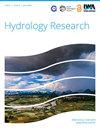利用区域尺度天气模型和长短期记忆网络对韩国某水坝集水区可能发生的极端干旱进行估计
IF 2.4
4区 环境科学与生态学
Q2 WATER RESOURCES
引用次数: 0
摘要
摘要要准备应对气候引起的极端干旱的措施,必须考虑各种天气条件。本研究试图使用天气研究与预报(WRF)模型生成极端干旱天气数据,并将其应用于长短期记忆(LSTM),一种深度学习人工智能模型,以产生径流,而不是使用传统的降雨径流模型。最后,利用产生的径流计算标准化流流量指数(SSFI),即水文干旱指数,预测极端干旱。因此,气象资料对径流的敏感性检验表明,使用相似类型的气象资料并不能改善径流模拟,其Nash-Sutcliffe效率最大差异为0.02。在2015年干旱年,与观测数据相比,WRF和LSTM产生的径流月径流量减少,SSFI值在−2以下更为严重。这显示了wrf生成的气象数据在利用数值表示模拟基于可能的大气物理条件的潜在极端干旱方面的重要意义。此外,LSTM可以模拟径流,而不需要目标流域的特定物理数据;因此,它可以模拟任何流域的径流,包括数据有限的发展中国家的流域。本文章由计算机程序翻译,如有差异,请以英文原文为准。
Estimation of possible extreme droughts for a dam catchment in Korea using a regional-scale weather model and long short-term memory network
Abstract To prepare measures to respond to climate-induced extreme droughts, consideration of various weather conditions is necessary. This study tried to generate extreme drought weather data using the Weather Research and Forecasting (WRF) model and apply it to the Long Short-Term Memory (LSTM), a deep learning artificial intelligence model, to produce the runoff instead of using conventional rainfall–runoff models. Finally, the standardized streamflow index (SSFI), the hydrological drought index, was calculated using the generated runoff to predict extreme droughts. As a result, the sensitivity test of meteorological data to runoff showed that using similar types of meteorological data could not improve runoff simulations with a maximum difference of 0.02 in Nash–Sutcliffe efficiency. During the drought year of 2015, the runoff generated by WRF and LSTM exhibited reduced monthly runoffs and more severe SSFI values below −2 compared to the observed data. This shows the significance of WRF-generated meteorological data in simulating potential extreme droughts based on possible physical atmospheric conditions using numerical representations. Furthermore, LSTM can simulate runoff without requiring specific physical data of the target catchment; therefore, it can simulate runoff in any catchment, including those in developing countries with limited data.
求助全文
通过发布文献求助,成功后即可免费获取论文全文。
去求助
来源期刊

Hydrology Research
WATER RESOURCES-
CiteScore
5.00
自引率
7.40%
发文量
0
审稿时长
3.8 months
期刊介绍:
Hydrology Research provides international coverage on all aspects of hydrology in its widest sense, and welcomes the submission of papers from across the subject. While emphasis is placed on studies of the hydrological cycle, the Journal also covers the physics and chemistry of water. Hydrology Research is intended to be a link between basic hydrological research and the practical application of scientific results within the broad field of water management.
 求助内容:
求助内容: 应助结果提醒方式:
应助结果提醒方式:


